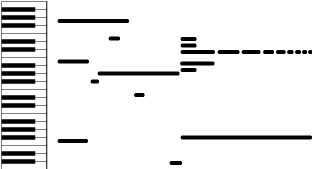Graphic notation
From Wikipedia, the free encyclopedia
Musical graphic notation is a form of music notation which refers to the use of non-traditional symbols and text to convey information about the performance of a piece of music. It is used for experimental music, which in many cases is difficult to notate using standard notation.
Graphic notation can come in various forms:
- Graphic scores, in which the music is represented using symbols and illustrations:
This notation may be, like music on traditional staves, a time-pitch graph system. In the above example, time is still represented by reading left-to-right.
- Prose scores, in which the music and its directions are written as ordinary text, and the interpretation is down to the performer.
One example of prose scores is John Cage's 4'33" where Cage writes his composition in prose describing at what dynamic the musician should play.
- Line staves showing relative pitch, with the actual pitches being decided upon performance.
- Piano Roll Notation, borrowed in the early 1950's and 1960's from piano rolls used for player pianos in the turn of the 20th century, this notation is now popular in computer MIDI sequencers to create music.
Contents |
[edit] Graphic symbols
A more common aspect of graphic notation is the use of symbols to convey information to the performer about the way the piece is to be performed. These symbols first began to appear in the works of avant-garde composers such as Karlheinz Stockhausen and Krzysztof Penderecki as well as the works of experimental composers such as John Cage and Earle Brown during the 1950s and 60s. Although this concept was closely related to the development of fully graphical notation, it is essentially different in that the symbols are intended to convey a concrete sonic result, whereas true graphic scores are often intentionally ambiguous, leading to many possible interpretations of the score. The following symbols are staples of contemporary scores:
| Line indicating relative duration | |
| Relative spacing between notes (as beams) | |
| Relative spacing between notes (as note heads ) | |
 |
"feathered beam," getting faster |
 |
"feathered beam," getting slower |
| highest possible pitch / lowest possible pitch | |
| tone cluster / tone cluster glissando | |
| long fermata |
[edit] Composers who have used graphic notation
Practitioners of graphic notation include:
- Anthony Braxton
- Earle Brown
- Herbert Brun
- John Bergamo
- John Cage
- Cornelius Cardew
- George Crumb
- Brian Eno
- Morton Feldman
- Barry Guy
- Alfred Harth
- Roman Haubenstock-Ramati
- Mauricio Kagel
- Panayiotis Kokoras
- György Ligeti
- Robert Moran
- Krzysztof Penderecki
- Nick Petrella
- Roger Reynolds
- Wadada Leo Smith
- Juan Maria Solare
- Jennifer Walshe
- Karlheinz Stockhausen
- Christian Wolff
- John Zorn
- Linda O Keeffe[1]
- Eric Ewazen
- R. Murray Shafer
- Nahneen Kula
[edit] See also
[edit] Further reading
- Cage, J. and Knowles, A. (1973). Notations. Reprint Services Corp. ISBN 0-685-14864-5.
- Tisano, Theresa Sauer (2008). Notations21. New York: Mark Batty Publisher.
[edit] External links
- Pictures of Music at Northwestern University
- Bergstroem-Nielsen, Carl: Experimental improvisation and notation practise 1945-1999; Experimental improvisation and notation practise, addenda 2000-. Online bibliographies.
- Real-time interpretation of Rainer Wehinger visualization of Ligeti's electronic work Artikulation
- An online collection of graphic scores curated by the New York Miniaturist Ensemble
- Notations21, an anthology of innovative musical notation
|
|||||||||||||||||||




